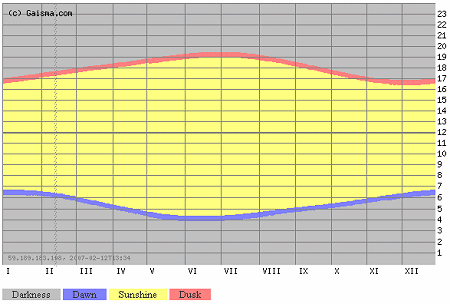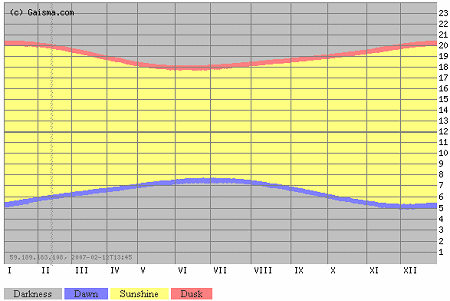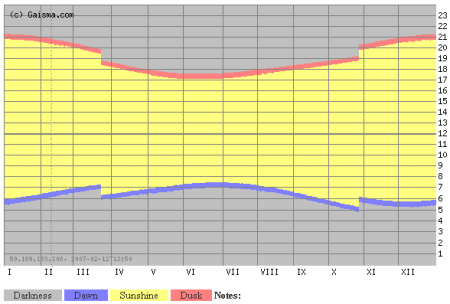Gaisma - real-life sine graphs
By Murray Bourne, 13 Feb 2007
Gaisma has
"Sunrise, sunset, dawn and dusk times around the World!".
There is a graph for each city and they are (almost) sine curves.
The yellow portion represents daylight, the gray represents night and the blue and red represent dawn and dusk. The horizontal scale is months in the year and the vertical scale is the hour of the day.
This is the one for Tokyo (northern hemisphere):

Capetown, South Africa, is in the southern hemisphere, so the graphs have the opposite shape (in a vertical sense).

Many places use daylight saving, and so there is a discontinuity in the graph. For example, Melbourne in Australia has:

There are some really strange graphs for places above the arctic (and below the antarctic) circle, like Tasiilaq, Greenland.
Now, the challenge is to model the graphs (find an equation for them), since they aren't exactly sine curves.
Oh, and:
"Gaisma" is a Latvian word, meaning "light".
It's an interesting site.
See the 5 Comments below.
25 Feb 2007 at 9:07 am [Comment permalink]
[...] squareCircleZ links to Gaisma on real-life sine graphs [...]
10 Jan 2009 at 10:01 pm [Comment permalink]
Very interesting these data, specially to integrate it in biological field, to understand circadian rhythm behavior according to light and dark hours, in differents latitudes. Right now I have in mind metabolism of certain components.
Marta
17 Jan 2009 at 8:24 pm [Comment permalink]
That sounds interesting too, Marta.
I wonder how much we are changing human circadian rhythms by leaving lights on for as long as we do. Lots of people have very strange sleeping habits...
18 Jan 2009 at 2:28 am [Comment permalink]
That’s quite right what you say about the changing of sleep habits Zac. Sometimes they are due to work exigencies (jet pilots and crew in international travels, night guardians, nurses, the list is long), therefore human life style modifications in our modern society could be produced by a broad environment manipulation (not natural one, but produced by human beings), and become a risk factor for several disorders. There is an interesting fact, that has been reported in scientifically literature. Dietary Reference Intakes (DRIs) developed by the Institute of Medicine (IOM) of the National Academy of Sciences, recommends for pregnant women: 1300 to 1000 mg daily Calcium intake for adolescents and young women respectively. Apart of the importance in healthy bone metabolism, it has been described also diminishing risk for preeclampsia occurrence (by some authors), but this Ca ingestion is not easy to attain, even in healthy and economically sufficient populations, Nevertheless, it was observed in other reports, that in many countries the low Ca ingestion did not badly influenced blood pressure values during pregnancy. Therefore, couldn’t be the daylight influence, taking into account also the seasonal factor combined with latitude a cause of this opposed results?
13 Mar 2019 at 11:43 pm [Comment permalink]
this is a cool sine graph!